Make sure your clothes are COVID-19 clean
Kathmandu
Hygiene is one of the most important precautionary measures to curb the spread of COVID-19. The majority of people have developed the habit of washing hands after returning home from the market, workplace or other public places. However, sometimes just washing your hands would not be enough as your clothes, shoes and hair can also track the virus into your home.
“In Nepal’s context, since COVID-19 has not become a huge public health problem, not everyone needs to panic about compulsorily washing their clothes each time they return home,” says public health specialist Prof Dr Sunil Kumar Joshi, who is also the Head of Department of Community Medicine, Kathmandu Medical College.
“Having said that, laundry hygiene along with personal hygiene and other safety measures need serious consideration if you are a healthcare provider, waste management worker or others working in the frontline coming in close contact with patients infected with COVID-19. Similarly, people who are residing in areas that have become hotspots or pocket areas of COVID-19 also have to be extra cautious about their hygiene including of their laundry if they go outside,” he cautions.
As per him, cleaning and disinfecting laundry depends on your degree of exposure to COVID-19. “If you think your clothes have been exposed to the virus, take them off safely as soon as you reach home, wash them using soap or detergent, creating foam, for at least one minute and dry them in sun after rinsing. Take precautions by wearing a mask and rubber gloves while washing,” he advises.
“If you wash your clothes in a washing machine, wear a mask when you put your contaminated clothes in the machine, wash your hands with soap and water after dealing with laundry, and also clean and disinfect the washing machine after use.”
When it comes to how long the virus can survive on clothes and fabrics, it is still unknown. However, since clothes would not only be made of fabric and since they may have metal or plastic parts like buttons and zippers, we have to clean our clothes properly. Researchers have found Severe Acute Respiratory Syndrome Coronavirus 2 (SARS-CoV-2) can live in aerosols for up to three hours, up to four hours on copper, up to 24 hours on cardboard and up to two to three days on plastic and stainless steel.
Dr Joshi says if there is little to no exposure to the virus on clothes, you can simply take off clothes and dry them in the sun for an hour. “If drying in the sun is not possible, pack those in disposable plastics until you do your laundry,” he says adding if you use clothes hampers to pile clothes, clean and disinfect the hampers after use.
As per Dr Joshi, maintaining physical distance while outside lessens the chances of clothes contracting the coronavirus which itself makes it less important to compulsorily wash your clothes each time you are out. He highlights the importance of maintaining physical distance (one metre), hand hygiene (frequently washing hand) and respiratory hygiene (covering mouth and nose with tissue paper, napkin, mask or elbow when coughing and sneezing) to prevent the spread of coronavirus.
Attention to hair, beard, footwear
Your hair and beard can also catch the virus. “So pay attention to your hair and beard and keep them clean,” he suggests.
As the virus can travel home through and remain active on your shoes, Dr Joshi advises to keep worn pairs isolated when you get home, and you can wash them if they are washable.
Laundry hygiene made easy
Centers for Disease Control and Prevention guidelines to clean, disinfect laundry — clothing, towels, linens and other items:
- Launder items according to the manufacturer’s instructions. Use the warmest appropriate water setting and dry items completely.
- Wear disposable gloves when handling dirty laundry from a person who is sick.
- Dirty laundry from a person who is sick can be washed with other people’s items.
- Do not shake dirty laundry.
- Clean and disinfect clothes hampers.
- Remove gloves, and wash hands right away.






